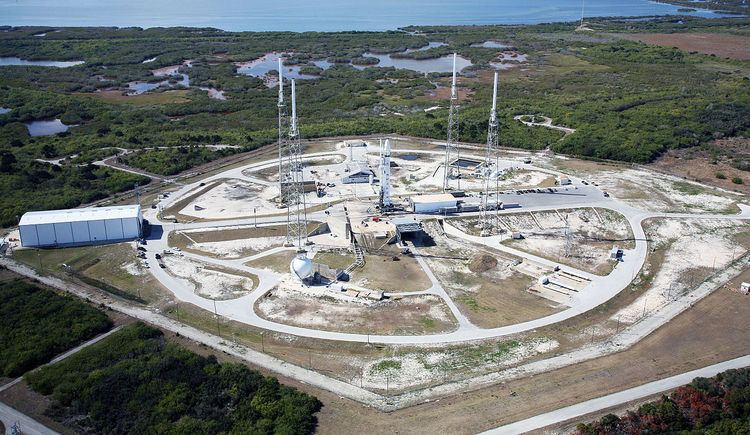Short name SLC-40 Address Cape Canaveral, FL, USA Total launches 79 | Min / max
orbital inclination 28°–57° Launch pad 1 | |
 | ||
Operator United States Air Force Status Damaged in pad explosion; inactive pending repairs First launch 18 June 1965
Titan IIIC / Transtage Last launch 14 August 2016
Falcon 9 Full Thrust / SpaceX JC-SAT 16 Launch site Cape Canaveral Air Force Station Similar Cape Canaveral Air Force, Cape Canaveral Air Force, Kennedy Space Center La, Cape Canaveral Air Force, Kennedy Space Center | ||
Cape Canaveral Air Force Station Space Launch Complex 40 (SLC-40), previously Launch Complex 40 (LC-40) is a launch pad for rockets located at the north end of Cape Canaveral, Florida.
Contents
The launch pad was used by the United States Air Force for 55 Titan III and Titan IV launches between 1965 and 2005.
After 2007, the US Air Force leased the complex to Space Exploration Technologies (usually shortened to SpaceX) to launch the Falcon 9 rocket. As of August 2016, there have been twenty-five launches of the Falcon 9 from the complex.
TitanEdit
The first launch from LC-40 was the maiden flight of the Titan IIIC (June 18, 1965), carrying two transtage upper stages to test the functionality of the vehicle.
Two interplanetary missions were launched from the pad:
A total of 30 Titan IIICs, 8 Titan 34Ds and 17 Titan IVs were launched between 1965 and 2005. The final Titan launch from SLC-40 was the Lacrosse-5 reconnaissance satellite carried on a Titan IV-B on April 30, 2005.
The tower was disassembled during late 2007 and early 2008. Demolition of the Mobile Service Structure (MSS), by means of a controlled explosion, occurred on April 27, 2008, by Controlled Demolition, Inc.
Falcon 9Edit
On April 25, 2007, the US Air Force leased the complex to SpaceX to launch the Falcon 9 rocket. During April 2008, construction started on the ground facilities necessary to support the launch of the SpaceX Falcon 9 rocket. Renovations included installation of new liquid oxygen and kerosene tanks and construction of a hangar for rocket and payload preparation.
The first Falcon 9 rocket arrived at SLC-40 in late 2008, and was first erected on January 10, 2009. It successfully reached orbit on its maiden launch on June 4, 2010, carrying a dummy payload qualification unit.
SLC-40 is the launch facility of the SpaceX Dragon, a reusable automated cargo vehicle which is currently being used to provide two-way logistics to and from the International Space Station; a role previously filled by the Space Shuttle until its retirement in 2011. SpaceX successfully launched the first test flight for the Dragon from SLC-40 on December 8, 2010. Its first attempt to launch to and dock with the International Space Station successfully occurred on May 22, 2012, following an abort after engine ignition three days earlier.
SpaceX modified the launch pad in 2013 in order to support launches of the Falcon 9 v1.1 launch vehicle, a 60 percent heavier rocket with 60 percent more thrust on realigned engines and 60 percent longer fuel tank than the v1.0 version of the Falcon 9, requiring a modified transporter/erector.
Accidents and incidentsEdit
On September 1, 2016 a Falcon 9 rocket was destroyed by an explosion that originated around the rocket's second stage in the process of running a routine static fire test on the SLC-40 launch pad. The explosion occurred during loading of LOX eight minutes prior to first stage engine ignition as part of the test. Subsequent to the explosion, this test event is reclassified as a Catastrophic Anomaly Test (CAT).
A static fire is a test performed prior to launch to verify that the vehicle is ready for flight. The test is identical to a launch until the moment of liftoff but instead of releasing the vehicle shortly after first stage engine ignition, the engines fire for a few seconds and then shut down. The second stage is fueled to test the interaction with the first stage but remains otherwise inactive. After completion of a static fire test, propellant and oxidizer are unloaded, the launch vehicle is lowered and returned to the hangar, and review and analysis of the data from the static fire is undertaken. Static fire tests are not common for most rocket launches these days, as most proceed without one. SpaceX does them to make sure the vehicle works as advertised.
The explosion resulted in a total loss of the rocket. The payload, an AMOS-6 satellite, was integrated with the vehicle at the time and was destroyed. Furthermore, the explosion caused extensive damage to the launch pad and was reported to have cracked nearby windows and to have been felt up to 40 miles away from the pad. There were no personnel on the pad and no injuries from the explosion were reported.
